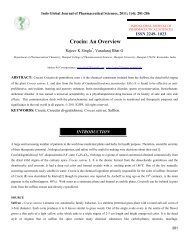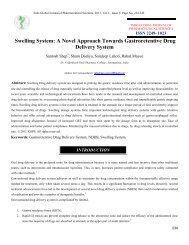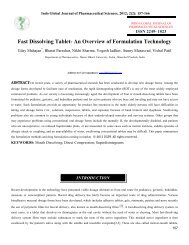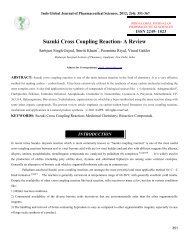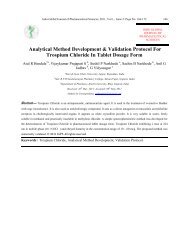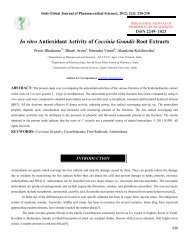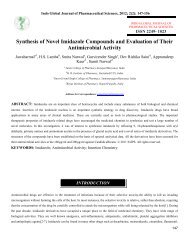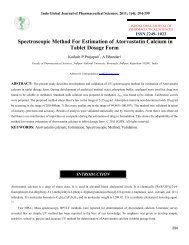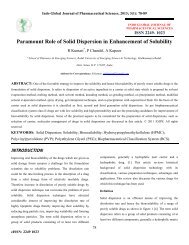Pharmacognostical Studies & Phytochemical Evaluation of the Stem ...
Pharmacognostical Studies & Phytochemical Evaluation of the Stem ...
Pharmacognostical Studies & Phytochemical Evaluation of the Stem ...
Create successful ePaper yourself
Turn your PDF publications into a flip-book with our unique Google optimized e-Paper software.
Indo Global Journal <strong>of</strong> Pharmaceutical Sciences, 2013; 3(1): 58-66INDO GLOBAL JOURNAL OFPHARMACEUTICAL SCIENCESISSN 2249- 1023<strong>Pharmacognostical</strong> <strong>Studies</strong> & <strong>Phytochemical</strong> <strong>Evaluation</strong> <strong>of</strong> <strong>the</strong> <strong>Stem</strong>Barks <strong>of</strong> Embilica Officinalis Gaertn.Prodyut Mondal, Saket Bihari Sharan, Md. Kamaruz Zaman * , Niroj Bhuyan, Sonjit DasDepartment <strong>of</strong> Pharmaceutical Sciences, Dibrugarh University, Dibrugarh, Assam-786004, IndiaAddress for Correspondance: Md. Kamaruz Zaman , z_kamar2003@yahoo.comABSTRACT: To investigate <strong>the</strong> pharmacognostic parameter, physico-chemical parameters, fluorescence analysis, preliminaryphytochemical screening, and Thin Layer Chromatographic analysis <strong>of</strong> <strong>the</strong> stem barks <strong>of</strong> <strong>the</strong> plant Embilica <strong>of</strong>ficinalis Gaertn. Theair-dried and powder bark <strong>of</strong> <strong>the</strong> plant Embilica <strong>of</strong>ficinalis Gaertn (Euphorbiaceae) were studied by morphology, microscopy,florescence analysis, preliminary phytochemical screening and thin layer analysis <strong>of</strong> powdered drug. O<strong>the</strong>r physicochemicalparameters were also performed as per WHO guidelines. The dried powder leaves were investigated by morphology. The results <strong>of</strong>physic-chemical parameters such as loss on drying, ash values and extractive values, fluorescence analysis, preliminary phytochemicalscreening and TLC are summarized here. The present information on <strong>the</strong> pharmacognostic evaluation <strong>of</strong> <strong>the</strong> plant drugEmbilica <strong>of</strong>ficinalis Gaertn delivered <strong>the</strong> qualitative and quantitative parameters serve <strong>the</strong> important information to <strong>the</strong> identity and todetermine <strong>the</strong> quality and purity <strong>of</strong> <strong>the</strong> plant material in <strong>the</strong> future. It also signify <strong>the</strong> important information <strong>of</strong> <strong>the</strong> closely related o<strong>the</strong>rspecies and varieties. © 2011 IGJPS. All rights reserved.KEYWORDS: Embilica <strong>of</strong>ficinalis Gaertn; Physico-Chemical <strong>Evaluation</strong>; Phyto-Chemical Screening; QualityControl Test.INTRODUCTIONPlants have been <strong>the</strong> basis <strong>of</strong> many traditional medicinesystems throughout <strong>the</strong> world for thousands <strong>of</strong> years andcontinue to serve mankind with new remedies. At present,<strong>the</strong>re is a worldwide movement for assessing <strong>the</strong> plantresources which are <strong>of</strong> medicinal and economical value andimportance. Researchers are focusing mainly onethnobotanical & ethnomedicinal investigations to fulfill <strong>the</strong>increasing demand <strong>of</strong> herbal products. In <strong>the</strong> last few decades<strong>the</strong>re has been an exponential growth in <strong>the</strong> field <strong>of</strong> herbalmedicine and <strong>the</strong>se drugs are gaining popularity both indeveloping and developed countries because <strong>of</strong> <strong>the</strong>ir naturalorigin and less side effects [1]. WHO estimate that, about 80%<strong>of</strong> <strong>the</strong> population in <strong>the</strong> developing countries depends directlyon plants for its medicine [2, 3]. In India 2000 medicinalpreparations used are <strong>of</strong> plant origin. India has a rich heritage<strong>of</strong> traditional medicine and <strong>the</strong> traditional health care systemhave been flourishing for many centuries.The North-East region <strong>of</strong> India (22 0 -29 0 N; 89 0 -97 0 E)comprises <strong>the</strong> Sikkim and <strong>the</strong> seven sister states namelyAssam, Arunachal Pradesh, Nagaland, Meghalaya, Mizoram,Manipur and Tripura. This region <strong>of</strong> India has several hillranges interspersed with valleys and is by large sparselypopulated. Nearly 40% <strong>of</strong> <strong>the</strong> total geographical area <strong>of</strong> thisregion is covered by evergreen forest. A large no <strong>of</strong> peopleeISSN: 2249 102358
Indo Global Journal <strong>of</strong> Pharmaceutical Sciences, 2013; 3(1): 58-66belonging to various groups <strong>of</strong> <strong>the</strong> nor<strong>the</strong>astern region <strong>of</strong> Indiastill practicing <strong>the</strong>ir own traditional heath care systems.Emblica <strong>of</strong>ficinalis Gaertn (syn. Phylanthus emblica) is a wellknown Indian traditional medicinal plant which is popularlyknown as AMLA (AMLAKHI –in Assam), belonging to <strong>the</strong>family Euphorbiaceae. It is widely available roadside tree <strong>of</strong>this region. The different parts <strong>of</strong> <strong>the</strong> trees have multidisciplinaryutility to human. In traditional system <strong>of</strong> medicine<strong>the</strong> fruits and barks are used as a tonic, diuretic and a laxative.The fruits are useful in treating asthma, bronchitis, intermittentfever and cardiac disorder. The roots are said to be an emetic.The root barks are useful in treating ulcerative stomatitis. Theleaves juice is used to treat fever, conjunctivitis, diarrhea anddysentery. The powder <strong>of</strong> seeds is useful to treat asthma,bronchitis and biliousness [4].The bark <strong>of</strong> E. <strong>of</strong>ficinalis may can be easily adulterated withinferior materials. This adulteration can be prevented bymeans <strong>of</strong> various evaluation parameters like microscopicstudy. Microscopy is an important tool for au<strong>the</strong>ntification <strong>of</strong>crude drugs and study <strong>of</strong> powdered drugs [5]. <strong>Evaluation</strong> <strong>of</strong>drug means confirmation <strong>of</strong> its identity and determination <strong>of</strong>its quality and purity and detection <strong>of</strong> nature <strong>of</strong> adulteration.The evaluation <strong>of</strong> a crude drug is necessary because <strong>of</strong> <strong>the</strong>semain reasonsi) biochemical variation in <strong>the</strong> drugs ii)detoriation due to treatment and storage, and iii) substitutionand adulteration, a result <strong>of</strong> carelessness, ignorance or fraud.Due to advancement in <strong>the</strong> chemical knowledge <strong>of</strong> crudedrugs, at present, evaluation also includes method <strong>of</strong>estimating active constituents present in <strong>the</strong> crude drug, inaddition to its morphological and microscopic analysis. With<strong>the</strong> advent <strong>of</strong> separation techniques and instrumental analysis,it is possible to perform physical evaluation <strong>of</strong> a crude drug,which could be both <strong>of</strong> qualitative and quantitative in nature[6, 7]. The present study on this plant was undertaken todetermine <strong>the</strong> pharmacognostical parameters for evaluating<strong>the</strong> plant material. Various parameters like macro andmicroscopic properties, physico-chemical evaluations like ashvalue, extractive value, loss on drying (LOD) and phytochemicalscreening test, TLC pr<strong>of</strong>iling and fluorescenceanalysis <strong>of</strong> powdered crude drug were carried out and somesalient qualitative as quantitative parameter were mentioned.MATERIALS & METHODSPlant materialThe stem barks <strong>of</strong> Emblica <strong>of</strong>ficinalis Gaerts. (Family -Euphorbiaceae) were collected from campus garden <strong>of</strong>Dibrugarh university, Dibrugarh, Assam, India in <strong>the</strong> month <strong>of</strong>August. The plant was identified and au<strong>the</strong>nticatedtaxonomically by Dr. B.K. Sinha at National Botanical survey<strong>of</strong> Shillong, India. A voucher specimen DU/PSc/HRB-01/2011 <strong>of</strong> <strong>the</strong> collected sample was deposited in <strong>the</strong>institutional herbarium for future reference.Plant pr<strong>of</strong>ileTaxonomical classification [8]• Kingdom : Plantae (Plants)• Subkingdom :Tracheobionta (Vascular plants)• Superdivision : Spermatophyta (Seed plants)• Division : Angiospermae (Flowering plants)• Class : Dicotyledonae (Dicotyledons)• Subclass : Rosidae• Order : Geraniales• Family : Euphorbiaceae• Genus : Emblica• Species : <strong>of</strong>ficinalis Geartn.Vernacular name [9]• English : Indian Goose berry• Sanskrit : Aamalaki• Assamese :Amlokhi• Bengali : Amloki• Hindi : AmlaReagent and ChemicalsAll reagents and chemicals used for pharmacognosticevaluation and phyto-chemical screening were analyticalgrade obtained from SRL Chemical, Rankem, Otto, HimediaPvt. Ltd. India.Organoleptic evaluationVarious sensory parameters <strong>of</strong> <strong>the</strong> plant material (such ascolour, odour, size, shape, and taste) were studied byorganoleptic evaluation.eISSN: 2249 102359
Indo Global Journal <strong>of</strong> Pharmaceutical Sciences, 2013; 3(1): 58-66Physico-chemical evaluationPhysico-chemical parameters such as <strong>the</strong> percentage <strong>of</strong> loss ondrying (LOD), total ash, acid insoluble ash, water soluble ashwere determined as per guideline <strong>of</strong> <strong>the</strong> Indian Pharmacopoeia[10]. Water and alcohol soluble extractive were estimated bycold maceration according to <strong>the</strong> method prescribed by WHO[11]. All <strong>the</strong> parameters were taken in triplicate and <strong>the</strong> resultswhich were obtained presented as mean ± standard error <strong>of</strong> mean(SEM).Macroscopic evaluationThe bark was morphologically studied for its size, shape,surface, fracture and configuration. The macroscopy <strong>of</strong> crudedrug includes its visual appearance to <strong>the</strong> naked eyes and itssensory characteristics [12, 13]. Simple microscope <strong>of</strong>magnification 10xs was used for <strong>the</strong> perception <strong>of</strong> specialstructural features such as:‣ Size and shape <strong>of</strong> <strong>the</strong> drug,‣ Colour and external marking‣ Fracture and degree <strong>of</strong> uniformity <strong>of</strong> <strong>the</strong> particles.‣ Surface appearance by reflected light, shiningparticles, fibres and crystals.Microscopic charactersSectioningObservation <strong>of</strong> Transverse Section (TS) and LongitudinalSection (LS) <strong>of</strong> a plant part reveals <strong>the</strong> arrangement <strong>of</strong> cellsin a tissue and structure and morphology <strong>of</strong> a particular cellfrom all angles. Thin Transverse Section (TS) andLongitudinal Section (LS) were cut using hand sectioningmethod and stained with saffranin. Then <strong>the</strong>se were mountedin glycerine and observed under microscope.Microscopic description <strong>of</strong> tissues are supplemented withmicrographs wherever necessary, photographs <strong>of</strong> differentmagnification were taken with Nikon Labphoto2 Microscopic unit.For normal observation bright field was used for <strong>the</strong> study <strong>of</strong>crystals, cork, parenchymatous cell and fibres. Descriptive terms<strong>of</strong> <strong>the</strong> anatomical features are mentioned as given in <strong>the</strong> standardanatomy books [14].60eISSN: 2249 1023Fluorescence AnalysisA small quantity <strong>of</strong> dried and finely powdered leaves samplewas placed on a grease free microscopic slide and added 1-2drops <strong>of</strong> freshly prepared solution, mixed by gentle tilting <strong>the</strong>slide and waited for 1-2 minutes. Then <strong>the</strong> slide was placedinside <strong>the</strong> UV viewer chamber and viewed in day light, short(254 nm) and long (365 nm) ultraviolet radiations [15, 16].The colors observed by application <strong>of</strong> different reagents invarious radiations were recorded.<strong>Phytochemical</strong> screeningPhytochemistry is <strong>the</strong> study <strong>of</strong> phytochemicals that is derivedfrom plants. In o<strong>the</strong>r word it is <strong>the</strong> study <strong>of</strong> plant’s secondarymetabolites, <strong>the</strong>ir identification, isolation, estimation andstandardization [17, 18, 19].The dried and coarsely bark sample was extractedsuccessively with petroleum e<strong>the</strong>r (60-80 0 C), chlor<strong>of</strong>orm,acetone, methanol in a soxhlet extractor & water by coldmaceration. The concentrated extracts were evaporated todryness and <strong>the</strong> extracts obtained with each solvent wereweighed. Their percentage was calculated in terms <strong>of</strong> initialair dried plant material. The colors <strong>of</strong> extracts were observed.The successive extract, as mentioned above, were subjected tovarious qualitative phyto-chemical test for <strong>the</strong> identification <strong>of</strong>chemical constituents present in <strong>the</strong> plant material.Thin Layer Chromatographic AnalysisPreparation <strong>of</strong> plates:Glass plates <strong>of</strong> 5 x 20-cm 2 size were coated with silica gel G with<strong>the</strong> help <strong>of</strong> spreader to a layer thickness <strong>of</strong> 0.25 mm. Afterspreading, <strong>the</strong> plates were first air dried and <strong>the</strong>n activated at 110 ºC for 30 min [20, 21].Application <strong>of</strong> sample:Sample solutions <strong>of</strong> tests were spotted using a capillary tube. Thespots were placed at equidistance from each o<strong>the</strong>r. The spot areawas kept 2cm above <strong>the</strong> base <strong>of</strong> <strong>the</strong> plate so that <strong>the</strong> spotting areadoes not be immersed in mobile phase in <strong>the</strong> developmentchamber.
Indo Global Journal <strong>of</strong> Pharmaceutical Sciences, 2013; 3(1): 58-66Mobile phases: The following solvent systems (SS-1, SS-2 &SS-3) were selected to run <strong>the</strong> TLC plates-SS-1: Petroleum e<strong>the</strong>r (40-60ºC): Ethyl acetate: Glacial aceticacid (4: 1: 2)SS-2: Toluene: Ethyl acetate: Formic acid (9: 0.5: 0.5)SS-3: Petroleum e<strong>the</strong>r (40-60ºC): Ethyl acetate: Glacial aceticacid (2.5: 1.5: 1)Development <strong>of</strong> chromatogram:The extracts were spotted on <strong>the</strong> plates with <strong>the</strong> help <strong>of</strong> finebore capillaries and chromatogram were developed inchromatographic chamber using different solvent systems in aroom temperature (31 º C and at an angle <strong>of</strong> 75 0 ). In all <strong>the</strong>cases <strong>the</strong> solvent system was allowed to run to a distance <strong>of</strong> 10cm from <strong>the</strong> point <strong>of</strong> application <strong>of</strong> <strong>the</strong> extract in <strong>the</strong> plates.The time required for <strong>the</strong> development varied from 30-40 min.After completion <strong>of</strong> run <strong>the</strong> plates were removed from <strong>the</strong>chamber and allowed to dry in air. These plates were observedafter development in Iodine-chamber for <strong>the</strong> presence <strong>of</strong> <strong>the</strong>spots and <strong>the</strong> R f values <strong>of</strong> <strong>the</strong> spots were calculated andrecorded. Retardation factor is <strong>the</strong> ratio <strong>of</strong> distance travelledby <strong>the</strong> solute to <strong>the</strong> distance travelled by <strong>the</strong> solvent.RESULTS & DISCUSSIONMacroscopic <strong>Evaluation</strong> The characters recorded aredescribed below.General appearance – Single or branched and entire orlongitudinally sliced stems.Colour- Light greyOdour – CharacteristicsTaste- AstringentShape- Rough surface.Physico-Chemical <strong>Evaluation</strong>sThe values <strong>of</strong> all determinations viz. Ash values, Extractivevalues and Loss on drying are summarized in Table 1. In thisevaluations <strong>the</strong> amount <strong>of</strong> acid insolubale ash is lesser thanwater soluble ash, where as <strong>the</strong> amount <strong>of</strong> total ash was nearlydouble <strong>of</strong> <strong>the</strong>ir water soluble ash.Microscopic Transverse section (T.S) and longitudinal section(L.S.) <strong>of</strong> stem barks Emblica <strong>of</strong>ficinalis Gaertn. are shown infig. 1 and 2.Sl. No. Parameters Average values <strong>of</strong> three replicates ± S.D <strong>of</strong> stembarks1. Total ash 10.334 ± 0.47142. Acid insoluble ash 0.567± 0.00083. Water soluble ash 6.507± 0.84484. Water soluble extractive 11± 0.81645. Alcohol soluble extractive 7± 0.81646. Loss on drying 7± 0.8164Table 1 Values <strong>of</strong> Physico-chemical parameters (Ash values, Extractive values and Loss on drying)eISSN: 2249 102361
Indo Global Journal <strong>of</strong> Pharmaceutical Sciences, 2013; 3(1): 58-66CORKPHELLOGENPHELLODERMPHLOEMPARENCHYMAFig.1. Transverse section (T.S) <strong>of</strong> stem barks Emblica <strong>of</strong>ficinalis Gaertn.FIBREMEDULLARYRAYSFig. 2 Longitudinal section (L.S.) <strong>of</strong> stem barks Emblica <strong>of</strong>ficinalis Gaertn.eISSN: 2249 102362
Indo Global Journal <strong>of</strong> Pharmaceutical Sciences, 2013; 3(1): 58-66Fluorescence AnalysisThe results were summarized in Table no 2.<strong>Phytochemical</strong> screening: Refer Table 3.Thin Layer Chromatographic AnalysisThe leaves extract showed three distinct spots with differentintensities. The colors are yellow, yellowish green and violet incolor respectively. The resultant R f values were summarized inTable -4.Powdered drug Visible/Day light UV 254 nm (short) UV 365 nm (long)Powder drug as such Light brown Brown Yellowish brownPowder + Methanol Light brown Yellowish brown Brownish blackPowder + 1% glacial acetic acid Brown Dark brown Blackish brownPowder +10% NaOH Yellowish brown Dark yellowish brown Bluish brownPowder + dil. NH 3 Yellowish brown Light brown BrownPowder + Conc. HNO 3 Brown Blackish brown Dark brownPowder+ dil.NH 3 +Conc.HNO 3 Yellowish brown Light brown Blackish brownPowder +1M H 2 SO 4 Brown Dark brown Yellowish blackPowder +1M HCl Brownish yellow Brown Dark brownPowder + 10% FeCl 3 Reddish brown Light brown Brownish yellowPowder +Acetone+ Methanol Light brown Brown BlackPowder +10% Iodine Yellowish brown Dark brown Blackish brownTable 2 Shows fluorescence analysis <strong>of</strong> powdered bark <strong>of</strong> E. <strong>of</strong>ficinalis Gaertn.Sl. No. Plant Constituents EXTRACTS (STEM BARKS)Petroleum Chlor<strong>of</strong>orm Acetone Methanol Watere<strong>the</strong>r(40°-60°c)1. Alkaloids: _ + + + _2. Carbohydrates _ _ + + +3. Glycosides _ _ + + +4. Steroids: + + + + _5. Fats and Oils: _ _ + + _6. Tannins and Phenolic _ _ + + +compounds:7. Proteins: _ _ + + +9. Gums: _ _ + + _10. Mucilages: _ _ _ _ _11. Flavonoids: _ _ + + +12. Lignin’s: _ _ _ _ _13 Triterpenes: _ _ _ _ _Table 3 Shows phyto-chemical screenings <strong>of</strong> successive extracts <strong>of</strong> stem barks <strong>of</strong> Emblica <strong>of</strong>ficinalis Gaertn. Here, ‘+’ indicatespresence ‘-’ indicates absenceeISSN: 2249 102363
Indo Global Journal <strong>of</strong> Pharmaceutical Sciences, 2013; 3(1): 58-66Sl. No. Chromatography Solvent Extracts Number <strong>of</strong>SpotsR f ValuesVisualizing Agents1.2.SS-1:Petroleum E<strong>the</strong>r :Ethyl Acetate :Glacial Acetic Acid(4 : 1 : 2)SS-2:Toluene :Ethyl Acetate :Formic Acid(9 : 0.5 : 0.5)3. SS-3:Petroleum E<strong>the</strong>r :Ethyl Acetate :Glacial Acetic Acid(2.5 : 1.5 : 1)Petroleum E<strong>the</strong>r 2 0.80Iodine0.86Chlor<strong>of</strong>orm 2 0.69Iodine0.84Methanol 3 0.830.650.76IodinePetroleum E<strong>the</strong>r 3 0.72Iodine0.770.81Chlor<strong>of</strong>orm 2 0.54Iodine0.71Methanol 2 0.64Iodine0.67Petroleum E<strong>the</strong>r 2 0.63Iodine0.74Acetone 1 0.73 IodineMethanol 3 0.28Iodine0.570.73Table 4. TLC pr<strong>of</strong>ile <strong>of</strong> Emblica <strong>of</strong>ficinalis Gaertn. <strong>Stem</strong> barks extracts.To ensure reproducible quality <strong>of</strong> herbal products, proper control<strong>of</strong> starting material is utmost essential. Thus in recent years <strong>the</strong>rehas been an emphasis in standardization <strong>of</strong> medicinal plants <strong>of</strong><strong>the</strong>rapeutic potential. Despite <strong>the</strong> modern techniques,identification and evaluation <strong>of</strong> plant drugs by pharmacognosticalstudies is still more reliable, accurate and inexpensive means.According to World Health Organization (WHO) <strong>the</strong> macroscopicand microscopic description <strong>of</strong> a medicinal plant is <strong>the</strong> first steptowards establishing its identity and purity and should be carriedout before any tests are undertaken [22]. Organoleptic evaluationis a technique <strong>of</strong> qualitative evaluation based on <strong>the</strong> study <strong>of</strong>morphological and sensory pr<strong>of</strong>iles <strong>of</strong> whole drugs [7]. TheOrganoleptic studies shows <strong>the</strong> important characteristics <strong>of</strong> <strong>the</strong>drugs, <strong>the</strong> outer structure <strong>of</strong> <strong>the</strong> barks, <strong>the</strong> surface <strong>of</strong> <strong>the</strong> barks, <strong>the</strong>typical tongue sensation and <strong>the</strong> odour may screen <strong>the</strong> preliminaryphytochemical constituents.Ashing involves an oxidation <strong>of</strong> <strong>the</strong> component <strong>of</strong> <strong>the</strong> product.A high ash value is indicative <strong>of</strong> contamination, substitution oradulteration. The Total ash usually contains carbonates,phosphates, silicates which includes both physiological and64eISSN: 2249 1023non-physiological. Acid-insoluble ash usually indicates <strong>the</strong>contamination with silicon material like earth and sand.Water-soluble ash was used for <strong>the</strong> estimation <strong>of</strong> <strong>the</strong> amount<strong>of</strong> inorganic elements. Extractive value represent <strong>the</strong>extraction <strong>of</strong> any crude drug with a particular solvent yields asolution containing different phytoconstituents. Thecomposition <strong>of</strong> <strong>the</strong>se phytoconstituents in that particularsolvent depends upon <strong>the</strong> nature <strong>of</strong> <strong>the</strong> drug and solvent used.By following <strong>the</strong> cold maceration method, <strong>the</strong> yield <strong>of</strong> watersolubleextractive was found greater than alcohol solubleextractives.Loss on drying value is an important parameter <strong>of</strong> crude drugevaluation, which helps in its preservation. The objective <strong>of</strong>drying <strong>of</strong> fresh material is to fix <strong>the</strong>ir constituents i.e. to checkenzymatic or hydrolytic reactions that might alter <strong>the</strong> chemicalcomposition <strong>of</strong> <strong>the</strong> drug and to reduce <strong>the</strong>ir weight and bulk.Microscopic method is one <strong>of</strong> <strong>the</strong> cheapest and simplestmethods to start with establishing <strong>the</strong> correct identification <strong>of</strong><strong>the</strong> source material [24]. The transverse section <strong>of</strong> E.0fficinalis bark exhibited different distinguished layers <strong>of</strong> cellsconsisting <strong>of</strong> cork cells, cortex, phelogen and pheloderm
Indo Global Journal <strong>of</strong> Pharmaceutical Sciences, 2013; 3(1): 58-66tissues. The Cork consists <strong>of</strong> elongated, thin walledparenchymatous cells. Cortex consists <strong>of</strong> 3-4 layers <strong>of</strong>collenchymatous cells. Phellogen consists <strong>of</strong> a row <strong>of</strong>tangentially elongated cells, Phelloderm consists <strong>of</strong>parenchymatous cells and Phloem parenchyma consists <strong>of</strong>rectangular cells and in <strong>the</strong> T.S <strong>of</strong> bark <strong>the</strong> groups <strong>of</strong> fibers arefrequently found associated with medullary rays. Medullaryrays are <strong>of</strong> 2-3 seriate and parenchyma consists <strong>of</strong> lignifiedcells.Fluorescence is <strong>the</strong> phenomenon exhibited by variouschemical constituents present in <strong>the</strong> plant material. Someconstituents show fluorescence in <strong>the</strong> visible range in daylight.The ultra violet light produces fluorescence in many naturalproducts (e.g. alkaloids like berberine), which do not visiblyfluoresce in daylight. If <strong>the</strong> substances <strong>the</strong>mselves are notfluorescent, <strong>the</strong>y may <strong>of</strong>ten be converted into fluorescentderivatives or decomposition products by applying differentreagents. Hence, some crude drugs are <strong>of</strong>ten assessedqualitatively in this way and it is an important parameter <strong>of</strong>pharmacognostical evaluation [15, 23].Five solvents were selected for <strong>the</strong> extraction <strong>of</strong> stem bark <strong>of</strong>Emblica <strong>of</strong>ficinalis Gaertn. i.e Petroleum e<strong>the</strong>r, Chlor<strong>of</strong>orm,Acetone, Methanol, and Water and different phytochemicaltests were performed. The petroleum e<strong>the</strong>r and <strong>the</strong> chlor<strong>of</strong>ormextracts <strong>of</strong> stem bark shown negative response for <strong>the</strong> entiretest, except sterols in <strong>the</strong> extract. But <strong>the</strong> chlor<strong>of</strong>orm extractwhich represents <strong>the</strong> presence <strong>of</strong> alkaloids. The acetoneextract and <strong>the</strong> methanol extract showed most <strong>of</strong> <strong>the</strong> testpositive. The presence <strong>of</strong> carbohydrates, proteins, glycosidesand tannins are in <strong>the</strong> water extract but <strong>the</strong> o<strong>the</strong>r compoundssuch as alkaloids, steroids, fats etc. are absence in this solvent.The preliminary phytochemical studies exhibited <strong>the</strong> presence<strong>of</strong> <strong>the</strong> maximum number <strong>of</strong> phytoconstituents in <strong>the</strong>methanolic extract <strong>of</strong> <strong>the</strong> stem bark <strong>of</strong> E. <strong>of</strong>ficinalis.TLC is produced with <strong>the</strong> aim <strong>of</strong> identifying <strong>the</strong> individualsubstances in a mixture and also for testing purity or forseparation <strong>of</strong> mixtures. The R f value indicates <strong>the</strong> position atwhich a substance is located in a chromatogram. It isappropriate to regard R f value as a guide for identification.Three different mobile phases and iodine used as visualizingagents as for consideration <strong>of</strong> TLC determination.Two spots were visualized in petroleum e<strong>the</strong>r & chlor<strong>of</strong>ormextract & three spots were shown in methanol extract wheneluted with solvent system-1. In <strong>the</strong> SS-2, three spots wereobserved in petroleum E<strong>the</strong>r & two spots in chlor<strong>of</strong>orm &methanol extract while in SS-3; two spots were noticed inpetroleum e<strong>the</strong>r, single spot in acetone & three spots inmethanolic extract.CONCLUSIONThe present pharmacognostic data emphasize <strong>the</strong> knowledge<strong>of</strong> quality and identity <strong>of</strong> <strong>the</strong> plant Emblica <strong>of</strong>ficinalis Gaertn.The qualitative and quantitative parameters serve <strong>the</strong>important information <strong>of</strong> <strong>the</strong> plant E. <strong>of</strong>ficinalis Gaertn. Theseinformation will also be helpful to differentiate Emblica<strong>of</strong>ficinalis Gaertn from <strong>the</strong> closely related o<strong>the</strong>r species andvarieties. In conclusion, <strong>the</strong> parameters which are reportedhere can be considered as distinctive enough to identify anddecide <strong>the</strong> au<strong>the</strong>nticity <strong>of</strong> this drug.REFERENCES[1] Grover J K., Yadav S. & Vats V., Medicinal plants <strong>of</strong> India withanti-diabetic potential, J Ethnopharmacol, 2002; 81: 81.[2] Pareek, S.K., Medicinal plants in India: Present status and futureprospect. In prospect <strong>of</strong> medicinal plants (eds Gautam P. L. et al),Indian society for plant genetic Resources, New Delhi, 1998; 5-14.[3] Mukhopadhaya, S., Conservation, protection and biodiversity <strong>of</strong>medicinal plants. In Prospects <strong>of</strong> medicinal plants (eds Gautam P. L.et al), Indian society for plant genetic Resources, New Delhi, 1998;15-28.[4] Herbal Medicine Research Centre, Institute for MedicalResearch, Kuala Lumpur. Compendium <strong>of</strong> Medicinal PlantsUsed in Malaysia. 2002; 2: 218.[5] Rangari VD. Pharmacognosy and phytochemistry. 1st ed. NewDelhi: Career Publications; 2006, p. 103-115.[6] Kokate CK, Purohit AP, Gokhale SB. Pharmacognosy. NiraliPrakashan; 38 th edition, Pune: 2007.[7] Kokate CK. Practical Pharmacognosy. Vallabh Prakashan; 4 <strong>the</strong>dition .New Delhi: 1994, Reprint 2004.[8] Indian Medicinal Plants -A compendium <strong>of</strong> 500 species Part 3by Orient Longman Publications, 1997; 256-263.[9] Onions, Alan: Siddha Medicinal Herbs As CosmeticsIngredients. SPC, March 1994.[10] Anonymous. Indian Pharmacopoeia. Vol. II. Controller <strong>of</strong>Publications, Edition 4 th , New Delhi: Government <strong>of</strong> India;1996.[11] Anonymous. Quality Control Methods for Medicinal Plant Materials(An authorized publication <strong>of</strong> World Health Organization, Geneva).New Delhi: A.I.T.B.S. Publishers & Distributors (Regd.); 2002.[12] Khandelwal K.R. Practical Pharmacognosy-Techniques andExperiments, 12th ediition, Nirali Prakashan, Pune, 2004 ;146-156.eISSN: 2249 102365
Indo Global Journal <strong>of</strong> Pharmaceutical Sciences, 2013; 3(1): 58-66[13] Wallis T.E. Textbook <strong>of</strong> Pharmacognosy, 5th edition, reprint, CBSpublisher and Distributors, New Delhi, 2005; 369, 371, 412[14] Esau K.et al., Plant Anatomy, 2nd edition.John wiley & sons,1965; 767-771.[15] Gupta MK, Sharma PK, Ansari SH, Lagarkha R.<strong>Pharmacognostical</strong> evaluation <strong>of</strong> Grewia asiatica fruits. Int JPlant Science 2006; 1 (2): 249-251.[16] Kokashi CJ, Kokashi RJ, Sharma M. Fluorescence <strong>of</strong> powderedvegetable drugs in ultra- violet radiation. J American PharmAssoc1958; 47:715-717.[17] Cadenas E., Packer L. Hand Book <strong>of</strong> Antioxidants, 2nd edition,Marcel Dekker, Inc., U.S.A., 2002; 1, 99.[18] Breitmaier E. Structure Elucidation by NMR in OrganicChemistry: A Practical Guide, 3rd revised edition, John Wiley& Sons Ltd., England, 2002.[19] Caballero B. Guide to Nutritional Supplements, Elsevier Ltd.,U.K.,2009; 19,48,145.[20] Evans W.C. Trease and Evans’ Pharmacognosy, 15th edition,W.B Saunders,2005; 538-547.[21] Colegate, S.M., & Molyneux, R.J. Bioactive Natural Products:Detection, Isolation and Structural Determination, 2nd edition,CRC Press, New York, 2008.[22] Anonymous. Quality Control Methods for Medicinal Plant Materials(An authorized publication <strong>of</strong> World Health Organization, Geneva).New Delhi: A.I.T.B.S. Publishers & Distributors (Regd.); 2002.[23] Ansari SH. Essentials <strong>of</strong> Pharmacognosy. Birla Publications Pvt. Ltd1 st edition . New Delhi: 2006.[24] Singh S, Manchawal L, Chauhan MG. Pharmacognostic study<strong>of</strong>male leaves <strong>of</strong> Trichosan<strong>the</strong>s dioica Roxb. With special emphasison microscopic technique. J Pharmacognosy & Phyto<strong>the</strong>rapy 2010;2(5): 71-75.Indo Global Journal <strong>of</strong> Pharmaceutical Sciences( ISSN 2249 1023 ; CODEN- IGJPAI) indexedand abstracted in EMBASE(Elsevier), SCIRUS(Elsevier),CABI, CAB Abstracts, ChemicalAbstract Services(CAS), American Chemical Society(ACS), Index Copernicus, EBSCO, DOAJ,Google Scholar and many more. For fur<strong>the</strong>r details, visit http://iglobaljournal.comeISSN: 2249 102366





